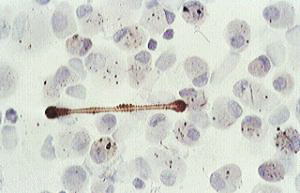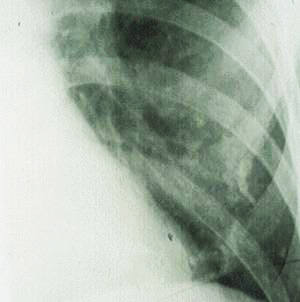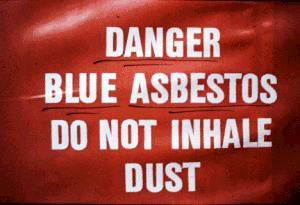Asbestos and disease
Introduction
This is an outline account of the risk of disease associated with asbestos exposure. For other matters related to occupational and environmental lung diseases.
Asbestos is a fibrous mineral, of which there are various types. The fibres are very narrow and are therefore easily respirable. Their resistance to chemical dissolution means that they will persist for a long time - perhaps indefinitely once they have settled in the lung.
Hazards and risks
A survey conducted by the Health and Safety Executive indicated that in the UK the highest risk of asbestos related lung disease arises from insulation work. In one group studied more than 10% of men died of mesothelioma. Epidemiologic work by Professor Peto has shown that in the first few years of the 21st century we can continue to expect a rise in the number of new cases of mesothelioma in Great Britain. Mesothelioma is a horrible cancer of the lining of the lung (usually), with a very long latency period (it can manifest itself 40 years after asbestos exposure or even longer).
Although it is difficult to estimate exposure-response relationships for mesothelioma, it may be somewhat easier to do so for asbestosis (a progressive fibrotic disease of the lungs caused by relatively heavy exposure to asbestos):
…“our best judgement as to the lifetime occupational exposure to asbestos at which the fibrotic process cannot advance to … Asbestosis is in the range of 25 f/cc-yrs and below” (Ontario Royal Commission, 1984).
Risk from exposure within buildings
There have been various attempts to estimate the risk from exposure within buildings and summaries of two of these are given below:
DOE (UK)
- Usually < 0.0005 f ml-1(> background, regulated fibres).
- 40 hrs/week for 20 years = attributable
- Life-time risk of death of ~1 = 100,000†
Ontario Royal Commission
- Assume 0.001 f ml-1
- Work exposure for 10 years = attributable risk of death risk 20:1,000,000*
*about 1/50 of death risk of 10mile drive/working day for same time
†about 1/100 of death risk for non-smokers from passive exposure to smoke ( ~ 1/10 cigarette/day)
NB: Chrysotile - building exposure - all UK population - attributable risk 1 p.a.
Therefore, provided the asbestos is well contained in structural elements such as tiles or cement, well sealed and left undisturbed (no drilling, sawing, or unscrupulous demolition), the risk of asbestos related disease should be negligibly small - arguably smaller than the risk of removing it.
Asbestosis, mesothelioma and other asbestos-related lung disease
Broadly speaking asbestos can cause two types of damage in humans: Cancer, e.g. mesothelioma; and fibrous thickening (either within the alveolar structure of the lung, or in its pleural lining)
Asbestosis is often classified separately from pneumoconiosis even though asbestos is a dust - but it is a special form of fibrous dust. Like silicosis, asbestosis is a serious condition which is incurable and can result in death at an early age. However, as is the case with many harmful substances, it does require a certain inhaled dose of asbestos before there is a measurable risk of asbestosis. Thus, living or working in a building in which asbestos has been used in construction and suitably sealed will not result in a high enough inhaled dose and thus cannot cause asbestosis.

The image above shows asbestos bodies in human bronchoalveolar fluid obtained through bronchoalveolar lavage (BAL) by the author for diagnostic and research purposes from a symptomatic worker who had significant exposure to asbestos (note alveolar macrophage cells adherent to the larger body, close to a large multinucleated giant cell, while in the bottom right hand corner a smaller body has probably been engulfed by a couple of the cells).

This photomicrograph shows an asbestos body under higher magnification, surrounded by alveolar macrophages (the phagocytic cells resident in the alveoli). Asbestos bodies are not simply asbestos fibres but are characterised by a covering containing iron and protein (ferritin). Note also the small dark inclusions in many of the macrophages - these are probably the consequence of tobacco smoking.

This chest radiograph above shows ‘benign’ disease of the pleura caused by asbestos exposure.
Asbestosis is often classified separately from pneumoconiosis even though asbestos is a dust - but it is a special form of fibrous dust. Like silicosis, asbestosis is a serious condition which is incurable and can result in death at an early age. However, as is the case with many harmful substances it does require a certain inhaled dose of asbestos before there is a measurable risk of asbestosis. Thus, living or working in a building in which asbestos has been used in construction and suitably sealed will not result in a high enough inhaled dose and thus cannot cause asbestosis.
Note: the term "asbestosis" is only used for one specific disease caused by asbestos and not for all its health effects. Other effects can include thickening and/or calcification of the pleura. Asbestos can also cause a special cancer of the pleura called mesothelioma as well as bronchial cancer similar to that caused by smoking.

Sadly, not all information or instruction is useful and appropriate. Information alone is not a substitute for reasonable risk reduction strategies. Consider the above photograph, for example. The photo was taken by the author in the 1980s. You would be very surprised to find out where: in a National Health Service hospital in England!
Would you consider that advising workers not to inhale blue asbestos is a reasonable way of protecting their health and preventing ill-health?
With an attitude such as the one exemplified by the above photo, it is not surprising that people will sadly continue to die of mesothelioma for decades to come as a legacy of the terrible indifference in the past.
Bronchial cancer (‘lung’ cancer)
The single most important known environmental respiratory carcinogen by far in man is tobacco smoke. However lung cancer may also be caused by other agents notably. asbestos, (but also certain compounds of nickel, polycyclic aromatic hydrocarbons (PAH), e.g. benzpyrene, arsenic trioxide and chromates).
Relative risk of Lung cancer†
There are about 45,000 deaths from lung (bronchial) cancer per year in U.K. and 90% of them are caused by tobacco smoking. If a person is a smoker as well as having been exposed to asbestos, then in absolute terms the risk of developing lung (bronchial cancer) is greater than the simple addition of the risks from tobacco or smoking alone.
| Non-Smokers | Smokers | |
|---|---|---|
| No known exposure to Asbestos | 1 | 11 |
| Heavy Asbestos exposure | 5 | 53 |
| e.g. chrysotile miners | 7** | 25** |
Light = 10 *
Moderate = 20 *
Heavy = 30* , 12 **
SMR = 1 + .01 f.ml-1 yrs
† Peto & Doll, 1985
* Doll & Hill, 1964
** McDonald et al, 1980
Mesothelioma
Exposure to asbestos dusts probably of all kinds but especially of blue asbestos (crocidolite) can cause mesothelioma which is a cancer of the pleural lining of the lung or much less commonly of the peritoneum. This disease is essentially incurable and commonly leads to a great deal of pain and other suffering. (This incidence of mesothelioma is besides an increased risk of lung cancer in the bronchus as with smokers and which has been discussed above). Hundreds of ex-workers still die of these diseases in the UK every year.
Prevention
Asbestos has now been banned for most purposes in most developed countries. Substitutes such as the various types of MMMF (man made mineral fibre) are generally much less hazardous although not completely free from risk. Sophisticated risk assessment and risk management steps must be in place prior to any asbestos demolition or clearance.
